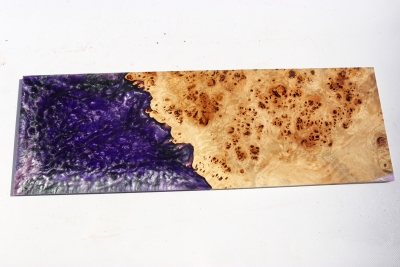Hybrid wood consists partially of wood, and partially of different coloured acrylic resins. They are merged (cast) in a special process. The resulting hybrid material can be processed easily and is dimensionally stable. You may need to sharpen your tools quite often. In order to achieve great visual effects, partly ground mother of pearl shell is used, which can blunt sharp cutting tools faster than usual.
We have produced the blank offered here for you using a complex process in our own production.
 The black poplar (Populus nigra) is a species of cottonwood poplar that grows in many parts of Central Europe. It prefers to live near riverbanks. In addition to a good water supply, it needs to be well-aerated gravel and sandy soil. Poplars usually live to about 150 years, occasionally even up to 300 years. The black poplar can reach heights of 80 to 100 feet.
The black poplar (Populus nigra) is a species of cottonwood poplar that grows in many parts of Central Europe. It prefers to live near riverbanks. In addition to a good water supply, it needs to be well-aerated gravel and sandy soil. Poplars usually live to about 150 years, occasionally even up to 300 years. The black poplar can reach heights of 80 to 100 feet.
The wood is soft, lightweight, and with long fibers. It can be worked with very sharp tools, making it very popular as carving wood. Larger pieces are mainly used as plywood. The burl wood from an enormous root ball can have brown eyes. It is gorgeous when polished and can have a stunning 3-D effect.
Dimensions: approx. 545 x 180 x 8 mm
You will get the shown piece!
For better visibility of the color and grain, the piece was sprayed with alcohol for the product photos.
The piece is dry and can be processed immediately
This saw veneer was sanded on both sides with at least 80 grain. The specified thickness has been precisely calibrated on our broadband sander so that you can start immediately.
Finely grained wood may contain imperfections such as open knots, bark inclusions, or cracks that are typical of the species. These flaws come from the way the tree has grown and are completely natural. They can usually be filled with low-viscosity cyanoacrylate (super glue) and wood dust.
Mandatory information according to the EU Product Safety Regulation (GPSR):
Manufacturer / person responsible:
Company FeinesHolz
Ulf Henke
Plauener Str. 163 / K
13053 Berlin
Berlin, Germany
E-Mail:
gpsr(at)feinesholz.de

